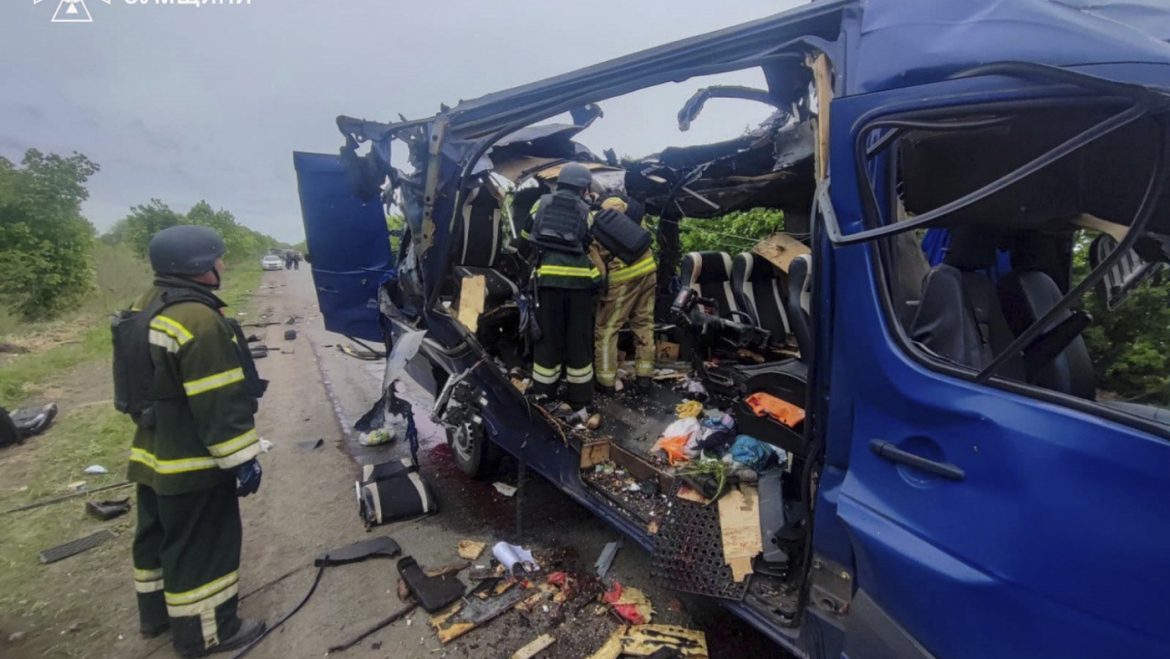A Deadly Drone Strike Amid Fragile Peace Efforts in Northeastern Ukraine
The ongoing conflict in Ukraine has witnessed another grim episode with a Russian drone attack striking a passenger bus in the northeastern Sumy region, resulting in the deaths of nine civilians and injuries to four others. This tragic incident not only underscores the escalating violence but also raises profound concerns about the conduct of warfare and the human cost of the conflict, particularly as it unfolded on the same day as rare direct peace talks between Moscow and Kyiv.
The Immediate Incident: Unraveling the Details
On a single day, a Russian drone struck a bus evacuating civilians from an active frontline area. The targeted vehicle was carrying innocent passengers, marking the attack as a severe blow against non-combatants. Ukrainian officials quickly condemned the strike, labeling it a “cynical war crime.” The attack’s proximity to peace negotiations added a stark irony to the development, as hopes for a ceasefire dimmed amidst continued hostilities.
Casualties and Context
The casualty count from this specific drone strike reached nine dead, with four more wounded. The bus was attacked in the Sumy region, a northeastern area of Ukraine that has seen repeated aggression during the conflict. Beyond this particular attack, other Russian missile and drone strikes targeted residential buildings and energy infrastructure in various parts of Ukraine on the same day, killing an additional several civilians and damaging critical infrastructure. Reports indicate at least 12 civilians died in missile attacks across the country, highlighting the widespread nature of the violence.
The escalating intensity is further emphasized by Ukrainian President Volodymyr Zelenskiy’s statement that Russia has launched over 1,000 drone strikes during the preceding week alone. This barrage has targeted urban centers, residential buildings, and civilian infrastructure, amplifying the country’s humanitarian crisis.
Broader Military and Political Implications
The drone strike’s timing—hours after direct peace talks between Ukraine and Russia—crystallizes the fragile nature of diplomatic efforts. The talks, the first in years, failed to yield any ceasefire or concrete agreement, and the attack appears to send a stark message of defiance from Moscow. Zelenskiy’s remarks also indicate that Ukraine is actively sharing intelligence with allies, particularly the United States, to expose Russian military actions and prepare for forthcoming threats. The anticipation of a forthcoming spring offensive in northeastern Ukraine has particularly heightened concerns over intensified conflict.
The recurrent targeting of buses and civilian evacuation routes not only intensifies the human toll but also potentially violates international laws protecting non-combatants. The deliberate or reckless targeting of civilian vehicles raises profound ethical and legal questions about the nature of Russia’s military strategy in Ukraine.
Humanitarian and Psychological Dimensions
For the people of Ukraine, such attacks inflict a traumatic imprint on the collective psyche, exacerbating fear and undermining trust in potential peace. The use of drones to provoke high-casualty incidents among vulnerable populations disrupts evacuation efforts, compounding the dilemma for civilians caught in conflict zones.
Moreover, the targeting of energy infrastructure alongside residential areas hints at a broader tactic aimed at destabilizing daily life, compromising essential services and magnifying civilian suffering during harsh winter months.
Media Reporting and Information Dissemination
News coverage from multiple international outlets aligns on the core facts of the incident while providing additional layers of context—such as statements from Ukrainian officials, casualty figures, and geopolitical implications. The repetition and cross-verification of reported details signify the attack’s significance in the ongoing conflict narrative. However, media reports also emphasize the unpredictability and escalating intensity of Russian drone and missile usage in the war, underscoring a pattern that Ukrainian authorities view as both tactical and symbolic.
Conclusion: A Grim Marker in an Unyielding Conflict
This Russian drone strike on a civilian bus in Ukraine’s northeastern Sumy region epitomizes the harrowing human cost wrought by the war and casts a long shadow over diplomatic overtures. It exemplifies the brutal intersection between military strategy and civilian vulnerability, reflecting both the intensification of Russia’s aerial assault campaign and the profound challenges facing peace efforts.
For Ukraine and the international community, this incident serves as a somber reminder of the urgent need for sustained, effective strategies to protect civilians, uphold humanitarian norms, and rekindle meaningful dialogue aimed at ending the conflict. Despite the bleakness, awareness and documentation of such attacks are crucial in shaping responses and holding perpetrators accountable, ensuring that the voices and lives of those affected are neither forgotten nor disregarded.


